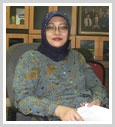Day 1 :
Keynote Forum
Hastari Wuryastuti
Gadjah Mada University, Indonesia
Keynote: Detection of the genotype and biotype variations of bovine viral diarrhea virus from persistently infected dairy cattle in Java, Indonesia
Time : 9:30-10:05

Biography:
Hastari Wuryastuti is a Professor in the Department of Veterinary Internal Medicine, Gadjah Mada University in Indonesia. She has completed her graduation from Faculty of Veterinary Medicine in 1979 and Masters and Doctor of Philosophy in 1987 and 1989 from Department of Large Animal Clinical Sciences, Michigan State University in USA
Abstract:
Bovine Viral Diarrhea Virus (BVDV) is one of important pathogen and costly diseases on dairy farm worldwide. A wide range of clinical manifestations from subclinical to fatal disease occur in association with BVDV infections. The reproductive consequences of BVDV infections range from conception failure, early embryonic death, abortions, stillbirth, congenital malformations, stunted weak calves and the birth of persistently infected (PI) calf (calves). Persistently infected calves are immune-tolerant and serving as BVDV carrier for their entire lives which continuously transmit the disease by direct contact to susceptible and unvaccinated herd mates. In the early genetic characterization, two genotypes of BVDV (BVDV-1 and BVDV-2) and two biotypes of BVDV (cytopathic and non-cytopathic) are recognized in most countries. The characterization of genotypes and biotypes from a particular region can contribute to a better understanding of the epidemiology and pathogenesis of BVDV infections. The objective of this study is to determine the genotype and biotype of BVDV variability from PI dairy cattle in Java, Indonesia. Bovine viral diarrhea virus (BVDV) positive samples were used in this study. Through phylogenetic and nucleotide sequence analysis of the 5’-Untranslated Region (5’UTR) of the samples investigated, it was determined that all the 15 field positive samples had the BVDV-1 genotype. Two IP-BVDV positive samples (805_FR and 5096_FR) sharing highest similarity (99% homology) with sub-genotype BVDV-1a KP941584 isolates which are currently circulating in Kansas, USA. Using immunoperoxidase monolayer assay (IPMA) the biotype of all the samples were identified as non-cytopathic-BVDV.
Keynote Forum
Raden Wasito
Gadjah Mada University, Indonesia
Keynote: An update: Avian influenza virus in chicken in Indonesia and how to eradicate it?
Time : 10:05-10:40

Biography:
Raden Wasito is a Professor of Veterinary Pathology at Department of Pathology, Faculty of Veterinary Medicine, Gadjah Mada University, Indonesia. He is currently a Staff Member at Faculty of Veterinary Medicine, Gadjah Mada University. He has received his DVM degree from Gadjah Mada University in 1978 and pursued his Advanced Degrees in Pathology at Department of Pathology, Michigan State University, USA and obtained MS in 1984 and PhD in 1987.
Abstract:
Avian influenza virus (AIV) is a zoonotic that can infect chickens and humans as a global public health threat. In the field, in general, AIV strains are harmless to human health. Nevertheless, several AIV strains, such as H5 and H7 subtypes, have been found to possess the ability to cross-link the host (genetic shift or genetic re-assortment) and are able to infect humans in case of direct contact with infected chickens or through contaminated environments. The incidence of AIV outbreaks is unpredictable and it only takes a week to infect chickens in many countries around the world. Chickens can be infected with hidden AIV, meaning that chickens is capable of transmitting AIV infection without showing clinical symptoms of sick or normal looking chickens (healthy). Java is noted as the region in Indonesia with the highest number of AIV cases in chickens and presumably a consistent main site as a source of AIV outbreaks in chickens. AIV subtype H5N1 has been successfully isolated from house flies (Musca domestica). AIV H5N1 subtype persists and lives in the digestive tract of the house fly up to 24 hours post-infection. In fact, it was reported that there has been a mixed infection of AIV type A highly pathogenic subtype H5 and H7 in chickens in Indonesia. Currently, AIV infection in chickens in Indonesia is non-pathogenic. The non-pathogenic AIV is, in general, co-infected with other microorganisms, especially Escherichia coli, Newcastle disease virus, infectious bronchitis virus and infectious bursal disease virus, and mycotic infections. AIV bio-surveillance in chickens is an essential part in order to identify new strains of AIV that are likely to cause epidemics and even AIV pandemics in both chickens and humans. More importantly, in addition to the anti-flies chemicals and vaccinations, are the creation of novel medicine in nature that allows it to act as a treatment (triggering T cell activity) and at the same time could prevent AIV (resulting in AIV receptors: sialic acid) and can also act as anti-bacterial G+ and G- and anti-toxin.
- Livestock and Health| Animal Disease Management & Traceability| Recent Technology in Optimising Livestock Production|

Chair
Raden Wasito
Gadjah Mada University, Indonesia
Session Introduction
Dragan Sefer
Belgrade University, Serbia
Title: The influence of different inorganic phosphorus sources in broilers diet on production results and bone mineralization

Biography:
Dragan Šefer has completed his PhD in 2002 at the Faculty of Veterinary Medicine, Department of Nutrition and Botany of Belgrade University, Serbia. He became Head of the Department in 2007 and since 2014 he has been engaged as a Full Professor. He has published more than 150 papers in national and international journals (more than 10 in reputed journals) and two books (General Nutrition and Feed Safety for Animals) intended for the students at the Faculty of Veterinary Medicine.
Abstract:
The aim of this trial was to determine the influence of monobasic calcium phosphate (MCP), as source of inorganic phosphorus, on production results of broilers, but also to determine the bone breaking strength, which indicates the level of availability of phosphorus from mineral nutrients. The trial included 200 broilers (Cobb 500), both sexes, from the same hatch. Broilers were divided in two groups, 100 each. During the 42 experimental days, which was divided in three phases (1-21, 21-35 and 35-42 days), groups were fed with different experimental diets. One group of broilers was fed with diet supplemented with MCP, provided by “Elixir Group” D.O.O., Sabac, Serbia. The other group was fed with diets supplemented with MCP originating from Russia. During the trial, health status and mortality were monitored on daily basis. Production results (average body weight, average daily gain, feed intake and feed to gain ratio) were monitored during the trial. At the end of the trial, 6 broilers from each group were slaughtered and the tibiae bone was examined on breaking strength. Production results of the first experimental group (fed with addition of MCP-Elixir), were significantly better, compared to the group fed with MCP from Russia (p<0.05). Bone breaking strength in the same group was higher but without statistical significance (p>0.05). The results of the experiment indicated that MCP as inorganic phosphorus source and has significant impact on growth, production performances, but also on level of mineralization of bones.
Jose A Rivera
University of Sao Paulo, Brazil
Title: Prevalence and classification of claw lesions in sows raised in technified farms, Lima, Peru

Biography:
Jose A Rivera is a Peruvian Veterinarian has field, commercial and academic experience in poultry farming and pig production and nutrition and passion in improving welfare and productivity. He has obtained his Master of Science degree, studied nutritional alternatives to reduce the negative impact of weaning on immunity, productivity and intestinal morphology in piglets. During his Doctoral degree, he has studied alternatives to the use of antibiotics in meat broilers and nutritional alternatives to reduce hull injuries in sows, decreasing its effects on productivity, welfare and consequently on the economy of the activity.
Abstract:
The productive efficiency in sows depends directly on the success of its reproductive management, aiming at producing more (quantity and individual weight of piglets) per female per year. The culling rate recorded as caused by claudication and hull injury on commercial farms is estimated at 15% and reproductive problems such as abortion, low numbers of newborn piglets, anestrus, recurrence of estrus, etc. are the main cause for culling, leading to a decrease the longevity of the farm, being considered as an economic and animal welfare problem. In 2007 a research showed that abscesses in the hind hooves are five times more correlated with acyclic ovaries than the body condition. We must consider than culling caused by underperforming or reproductive problems, in most cases, are related to hull injuries, even if subclinical. Thus, it is estimated that locomotor problems are related to at least 47% of the cullings. The objective of this study was to know the prevalence of hull injuries in sows in farms in Lima Peru. For this, a cross-sectional study was carried out; where 400 females from 1 to 13 births of the same genetics, raised in farms with similar conditions of climate, floor and management. Eight types of lesions were evaluated in the posterior hulls and each classified on a discrete scale from 0 to 3, where 0 was the absence and 3 were severe lesions. The results showed that 98.5% of the evaluated animals presented at least one lesion in the hull, 29.5% had mild lesions, 45.5% moderate lesions and 23.5% severe lesions. 100% of primiparas presented some type of lesion and the most frequent lesion was overgrowth and erosion of the sole. Even these data belong to a specific place, the conditions and the genetics of the animals are often found in several countries of the world. In 2013, data were presented showing similar ratios in Brazil.
Biography:
Abstract:

Biography:
Raden Wasito is a Professor of Veterinary Pathology at Department of Pathology, Faculty of Veterinary Medicine, Gadjah Mada University, Indonesia. He is currently a Staff Member at Faculty of Veterinary Medicine, Gadjah Mada University. He has received his DVM degree from Gadjah Mada University in 1978 and pursued his Advanced Degrees in Pathology at Department of Pathology, Michigan State University, USA and obtained MS in 1984 and PhD in 1987
Abstract:
Avian influenza (AI) and Newcastle disease (ND) are two important viral diseases of poultry, which often lead to similar clinical signs and pathological lesions in poultry. Highly pathogenic AI and ND lead high morbidity and mortality, causing huge economic losses to the poultry industry. Confirmatory diagnostics are necessary to distinguish between these two important viral diseases. The aims to this investigation was to assess the specificity of two biotin-streptavidin immunohistochemistry tests (IHC-SB) to differentiate between infection caused by virulent Newcastle disease virus (vNDV) and highly pathogenic avian influenza virus (HPAI) in a commercial poultry farm. The laying hens showed clinical signs of torticollis and paralysis, as well as hemorrhagic lesions in the lungs and/or digestive system. The lungs, brains and digestive tract samples were collected tested with IHC-SB tests specific for either vNDV or HPAI. The results showed that these tests could be used to safety and reliably detect vNDV and HPAI-specific antigen in infected cells, thus confirming their role in definitive differential diagnosis between these two pathogens.
Komireddy Kondal Reddy
College of Veterinary Science, India
Title: Effect of feeding certain probiotics on the performance of lactating lambs

Biography:
Komireddy Kondal Reddy has completed his MVSc, PhD (Australia), PDF (Japan), interested in the field of veterinary science and currently he is working as a Registrar at PV Narsimha Rao Telangana Veterinary University, India. He has published more than 120 papers and received many awards including ICAR Junior Fellowship, Common Wealth Fellowship, Japan Science and Technology Fellowship, State Best Teacher Award, University Best Teacher Award, 2 Best Research Paper Awards, Rythu Nestham Award, Best Video presentation award for the French project by PRSI, SAB Honorary Fellowship and Outstanding Achievement Award by the Society for Applied Biotechnology for 2016, etc.
Abstract:
The objective of this study was to find the influence of administration of certain probiotics (Pediococcus acidilactici and Saccharomyces boulardii) in lambs on certain health parameters. The study used three weeks old 18 suckling lambs of either sex of Decanni breed, each weighing about 7.0 kg. Standard starter ration with 12% CP was given with routine deworming practice. The experiment design comprised of three groups each consisting of six lambs. No probiotic was given to the control lambs in Group C except the standard starter ration, whereas lambs in group PA received lyophilized P. acidilactici at 30 mg/day/lamb for 1st 5 weeks of experiment and at 50 mg/day/lamb for the rest of 5 weeks and lambs in group SB received lyophilized S. boulardii at 30 mg/day/lamb for 1st 5 weeks of experiment and at 50 mg/day/lamb for the rest of 5 weeks of experiment, so as to provide 107 to 1011 CFU/day/lamb. Body weights of all the lambs in 3 groups were recorded at weekly intervals for 10 weeks (4th to 13th week of age). Growth performance (body weights), serum cholesterol, serum triglycerides, serum calcium (using ERBA Mannheim Instrument and ERBA chemical kits), fecal coliforms and immunity response using Brucella plain antigen and estimating antigen titer). Statistical evaluation of the results was done by analysis of variance test with the 5% level of significance. The results indicated no significant difference in the serum parameters but a significant (p<0.01) body weight gain was recorded in both the probiotic supplemented groups (PA and SB). The coliform counts in feces were significantly decreased in lambs fed with probiotics (PA and SB) compared to the control group. There was no significant increase of HI titers statistically in probiotic fed lambs (PA and SB groups) compared to control group. However, the HI titers of probiotic fed lambs were numerically higher compared to control lambs in 1st and 4th week indicating development of a moderate level of immunity in probiotic fed lambs against brucellosis.
D S Rawat
Watershed Management Directorate, India
Title: Culture and antibiogram studies in dogs with hemorrhagic gastroenteritis

Biography:
D S Rawat is a Senior Veterinarian and has been consistently working with the Governmental Organization for the past 17 years holding various positions in a diversified scenario like Dairy Development Department, Animal Husbandry Department, Rural Development Department. He is presently working as a Deputy Director (Planning) in Watershed Management Department in the state of Uttarakhand, India. He has graduated in Veterinary Sciences and Animal Husbandry in the year 2000 from GBPUA&T Pantnagar, Uttarakhand, India and did Post-graduation Diploma in Small Animal Emergency and Critical Care Medicine from TANUVAS, Chennai, India, in the year 2015. He has been implementing and facilitating the ongoing community development projects with new technological advancements, innovations in livestock and linking them with the premier institutes of the country with inclusiveness of environmental impact of animal production, ration balancing program to avoid over production of greenhouse gases and livestock waste management programs.
Abstract:
Hemorrhagic gastroenteritis in canines is of high clinical significance and is characterized by acute hemorrhagic diarrhea and marked hemoconcentration. In critical cases, there is severe hypoproteinemia, sepsis, hypovolemic shock, disseminated intravascular coagulopathy and death. Culture for fecal pathogens like Yersinia spp., Campylobacter spp., Clostridium spp., salmonella spp., Escherichia coli, etc. and an in vitro antibiotic sensitivity test helps the clinician in selecting the most appropriate antimicrobial agent. A study was carried out with the objective of culture and antibiogram studies in dogs with hemorrhagic gastroenteritis, at Madras Veterinary College, Chennai, keeping into account of the objectives, the parameters like prevalence of hemorrhagic gastroenteritis with reference to overall, age and sex wise, and season wise, parasitological examinations and its prevalence, bacteriological examinations and antibiotic sensitivity test. Various aspects of hemorrhagic gastroenteritis in dogs with regards to its prevalence, clinical signs, hematological, biochemical, histopathological changes and therapy for dehydration, water, electrolyte loss and elimination of primary cause had been taken into account in detail. The overall prevalence of gastroenteritis in dogs was 40% of 200 dogs. Highest prevalence with respect to age was recorded in 0-5 month (37.50%) followed by 6-11 month (27.50%), 1-2 years (22.50%) and above 2 years (12.50%). Sex-wise highest prevalence was recorded in males (62.50%) than in female dogs (37.50%). Season-wise highest prevalence was recorded in winters (27.50%) followed by monsoon (37.50%) and summers (35%). A total of 40 fecal samples were screened out for parasitic infestations, out of which 16 (40%) showed presence of parasitic infestation. Highest prevalence was recorded with Ancylostoma caninum, followed by Toxocara canis, Taenia hydatigenia and Toxascaris leonine, respectively. The highest prevalence was of E. coli 08 (33.33%) followed by Satphylococcus aureus 05 (20.83%), Campylobacter jejuni 04 (16.67%), Proteus vulgaris 03 (12.50%), Pseudomonas aeruginosa 03 (12.50%) and Shigella dysenteriae 01 (4.00%) respectively. Antibiotic sensitivity test was performed by using pure culture of different bacterial agents which were isolated from fecal samples. Total eight antimicrobial agents employed for drug sensitivity test were Ciprofloxacin, Enrofloxacin, Gentamicin, Chloramphenicol, Ampicillin, Penicillin, Tetracycline and Streptomycin. It was observed that E. coli organisms were strongly sensitive to Ciprofloxacin and Enrofloxacin (100%) followed by Gentamicin (88%), Chloramphenicol (55%), Ampicillin (11%), Penicillin (5%) and resistant to Tetracycline and Streptomycin. Nearly all strains were sensitive to Polymixin-B, Gentamicin, Furazolidone and Nitrofurantoin but resistant to Penicillin, Erythromycin and Sulfonamides.
Fon Fabian Nde
University of Zululand, South Africa
Title: The effect of polyethylene glycol on in vitro digestibility of tanniferous browses by goat microbial consortia

Biography:
Fon Fabian Nde is a PhD in Ruminant Nutrition, graduated from the University of KwaZulu-Natal, South Africa and currently working as a Lecturer at the University of Zululand after serving as a Post-Doctorate Researcher at UNIZULU and UZ. He is a Member of the South African Society of Animal Science, Golden Key International Honor Society and EAAP. His research focuses on improving forage digestion in ruminants especially with potential fibrolytic microbes from wild herbivores.
Abstract:
Tannin content in browse species exerts a significant negative effect on ruminant feed intake and digestion. Polyethylene glycol 4000 (PEG 4000) can help to alleviate the adverse effects of tannin rich feed on ruminant nutrition. This study evaluated the effect of PEG 4000 on goat microbial consortia in vitro degradability of tanniferous feeds. Microbial consortia were created by mixing fecal inoculum from goat, impala, giraffe and kudu as follows; N1 (goat+impala, 1:1), N2 (goat+kudu, 1:1), N3 (goat+giraffe+kudu, 1:1:1) and N4 (goat+giraffe+kudu+impala, 1:1:1:1). For microbial consortia cellulase and hemicellulase activities, crude protein enzyme extracts (CPZ) were precipitated from fresh fecal inocula by 60% ammonium sulfate and assayed for hemicellulase, endocellulase and exocellulase activities by incubating with xylan, carboxymethyl cellulose and crystalline cellulose containing 100 µL of 10% condense tannin and 50 µL of 5% (PEG 4000) respectively. In vitro degradability was carried out by transferring 33 ml of fecal consortia inoculum into 67 ml salivary buffer containing 1 g of Acacia sieberiana, 10% tannin and 5% PEG4000 before incubating for 72 hours at 38 ºC. Apparent degradability (APD), true degradability (TD), neutral detergent fiber degradability (NDFdeg), acid detergent fiber degradabilty (ADFdeg), cellulose digestibility (CELLdeg), hemicellulose degradability (HEMdeg) and microbial yield (MY) were measured. An increase (P <0.05) in enzyme activities was observed with the addition of PEG. The highest (P<0.05) endocellulase, hemicellulase and exocellulase activities influenced by PEG were observed in N1 followed by N4. The results showed that PEG generally increased (P<0.05) in vitro degradability of Acacia sieberiana. Microbial consortium N1 showed the highest increment in degradability when PEG was added for TD, NDFdeg, ADFdeg and CELLdeg. The second highest for the same parameters was observed in N2, followed by N4 while the lowest was observed in N3. For HEMdeg PEG effect was not significant (P>0.05) among ecosystems but were classified as N3, N2, N4 and N1 based on the relative increment observed. Improvement in fiber and Acacia sieberiana digestibility after inclusion of PEG clearly emphasized the negative effect of tannins on browses. Therefore, there is a need for constantly researching on novel technologies that will decrease its effect and improve energy harnessing from tanniferous browsed species by domestic browsers.
Mandeep Singh Azad
Sher-e-Kashmir University of Agricultural Sciences and Technology of Jammu, India
Title: Use of locally available leaf meals for improving growth and controlling parasitic infection in goats of hilly areas in Jammu and Kashmir, India

Biography:
Mandeep Singh Azad is currently working as a Scientist in Sher-e-Kashmir University of Agricultural Sciences and Technology of Jammu from last 7 years. He has an experience of working in remote areas with specially small and marginal farmers. He has done his Masters from National Dairy Research Institute in Animal Genetics and Breeding. He has made around 100 research contributions in the form of research papers, popular articles and abstracts in international and national journals. He has also published 3 books with international and national publishers. He is mainly working for transfer of technology from labs to farmer’s field. He is a member of various organizations related to animal sciences and agriculture.
Abstract:
Gastrointestinal parasitism especially Haemonchus contortus is a major problem in goat production worldwide, these parasites cause diarrhea, anemia, reduced weight gain and thus result increased production costs. The locally available fodder trees like Kikkar (Acacia nilotica), Amla (Emblica officinalis), Jamun (Syzygium cuminii), Dhaman (Grewia optiva), Mango (Mangiferra indica) found in hilly areas of Jammu and Kashmir can be used in complete feed blocks to meet the protein deficiency as well as control the parasitic load of the livestock. Crude protein content of these leaves were 20.00±0.44, 10.58±0.54, 11.02±0.11, 25.56±0.48, 10.62±0.57, respectively. The study was carried out to assess the effect of complete feed blocks and condensed tannins (CT) supplementation through leaf meal mixture (LMM) on feed intake and fecal egg counts in Haemonchus contortus infected goat. 30 goats were randomly divided into three groups (C, T1 and T2) of 10 animals in each group in a completely randomized block design for a period of 3 months. T1 group was supplemented with complete feed blocks without any leaf meal mixture whereas T2 group was supplemented with leaf meal mixture @ 1.5%. Body weights were recorded at day 0 and then 15 days interval for a period of 90 days. The fecal samples were collected at 0,7th, 15th day and thereafter at 15 days intervals for a period of 3 months for the assessment of feed intake, body weight changes and H. contortus loads. Feed intake and weight gain was almost similar in both the treatment groups T1 and T2 but were comparatively better than the controlled group with normal feeding. The mean fecal egg counts was significantly (P<0.001) higher in T1 group as compared to T2 group. It may be concluded that dietary supplementation of CT (1.5%) through LMM improved the overall growth and production and thus can help poor hilly farmers in making goat farming an economically viable enterprise. Supplementation of CT through leaf meal mixture could be used as an alternative sustainable method to control H. contortus infection.
Msimango Nokwethemba Nqobile Philile
University of Zululand, South Africa
Title: Effect of tannin on the fibrolytic potential of domestic, wild and consortia from browsed herbivores microbial ecosystems

Biography:
Msimango Nokwethemba Nqobile Philile is currently a PhD student in the Department of Agriculture at the University of Zululand, South Africa. Her research focuses on improving forage utilization in ruminants with potential fibrolytic microbes from wild herbivores for better animal productivity.
Abstract:
Trees and shrubs are important sources of forage (protein supplement when both quality and quantity of pastures are limited) for animals particularly during the long dry seasons of West Africa or winter in Southern Africa. However, their consumption is restricted by the presence, variation and complexity of phenolic compounds called tannin. Therefore, browsing different microbial ecosystems in search of potential microbes that have evolved in their ability to digest fiber and tannin tolerance can be important to improve browse digestion by domestic browsers. This study monitored the effect of tannin on the fibrolytic potential of microbial ecosystems from domestic goat, wild giraffe, kudu, impala and consortia [A1 (giraffe+kudu, 1:1), A2 (giraffe+impala, 1:1), A3 (kudu+impala, 1:1), and A4 (giraffe+kudu+impala, 1:1:1)]. Fresh fecal samples were collected and 50g was mixed with homogenization buffer (50 ml) for crude protein extraction. Crude protein enzyme extracts (CPZ) were precipitated with 60% ammonium sulfate and assayed for exocellulase, endocellulase and hemicellulase by incubating with crystalline cellulose, carboxymethyl cellulose and xylan at 38 °C with optimum pH of 5.5 to 6.5 for 1, 2 and 48 hours, respectively. Each reaction mixture contained 100 μL of 10% tannin acid while the control had no tannin. Enzyme specific activities were defined as μg of reducing sugar/mg CPZ. In vitro fermentation study was done by transferring 33 mL of fresh fecal inoculum into 67 mL of salivary buffer containing 1 g Acacia sieberiana and 10% tannin (substrate 6.2% was made up to 10% by adding 50 μL containing 3.8 mg tannic acid) before incubating for 72 hours at 38 °C. The control incubations had no tannic acid. Apparent degradability (APD), true degradability (TD), neutral detergent fiber degradability (NDFdeg), acid detergent fiber degradability (ADFdeg), hemicelullase degradability (HEMdeg), microbial yield (MY), metabolizable energy (ME) and total gas emitted (GAS) were measured. Endocellulase and hemicellulase activity were generally higher (P<0.05) when incubated with tannin than no tannin with the highest activity observed in impala. Exocellulase activity increased (P<0.05) in all systems when incubated with tannin but for goat that decreased. Impala and A1, showed the highest (P<0.05) exocellulase activity. Apparent degradability, TD, NDFdeg and ADFdeg varied (P<0.05) between microbial ecosystems incubated with tannin and no tannin as well as among the tannin treatment groups. True degradability increased (P<0.05) in all systems when incubated with tannin than no tannin. Impala and A1 showed the highest TD, NDFdeg and ADFdeg. Apart from goat and A2, HEMdeg tended to increase upon incubation with tannin. Metabolizable energy decreased with tannin incubation. The highest decreased in GAS was observed in goat followed by A1, A4 and A3. However, GAS increase in impala, kudu and giraffe. The results from this study demonstrated that wild herbivores especially IM and A1 consortia possess a higher fibrolytic potential under high tannin concentrations. It was also noticed that tannin plays a major role in reducing enteric GAS production especially in microbial consortia which is a major environmental concerned for global warming. Therefore, investigating these microbial ecosystems effect on domestic goat both in vitro and in vivo may improve browse utilization and decrease enteric gas production.
Eswara Prasad
College of Veterinary Science Tirupati, India
Title: Study on antioxidant activity, growth performance and carcass characteristics in broiled chicken fed with methanolic extract of Caesalpinia sappan L

Biography:
Eswara Prasad is a Professor of Veterinary Biochemistry and is presently working as Dean of College of Veterinary Science, Tirupati, India and guided many postgraduate and doctorates in Veterinary Biochemistry. He has published more than 40 research papers in reputed journals and had Postdoctoral training at Kansas State University, USA. Presently, he is working on Nanosilver mediated herbal extracts and their effects in clinical cases and has a long experience of teaching.
Abstract:
An experiment was conducted to evaluate the effects of methanolic extract of Caesalpinia sappan supplementation on the antioxidant status and growth performance of broiler chicken during summer months. 100 days old broiler chicks were randomly assigned into 5 groups. Control group I was given basal diet and treatment groups II, III and IV were supplemented with methanolic extract of Caesalpinia sappan stem bark at 100, 300 and 500 ppm respectively and group V was supplemented with vitamin E at 100 ppm as an antioxidant control through drinking water from day 0 to 8 weeks of age. All the C. sappan supplemented groups showed significantly lowered levels of malondialdehyde (MDA) and higher levels of reduced glutathione, GPx, SOD and catalase in liver and kidney tissues as compared to control. The serum levels of ALT, AST, CK and cholesterol were significantly lower in treatment groups III and IV when compared with control. However, serum T3 levels showed no significant change among different groups. Groups IV and III showed higher weekly feed intake, body weight gain and feed conversion ratio compared to control group. Higher dressing yields and abdominal fat percentages were observed in group IV compared to control. It could be concluded that, supplementation of C. sappan extract improved antioxidant status and growth performance in broiler chicken and can be considered as a replacement for synthetic antioxidant in poultry diet in heat stress conditions.
